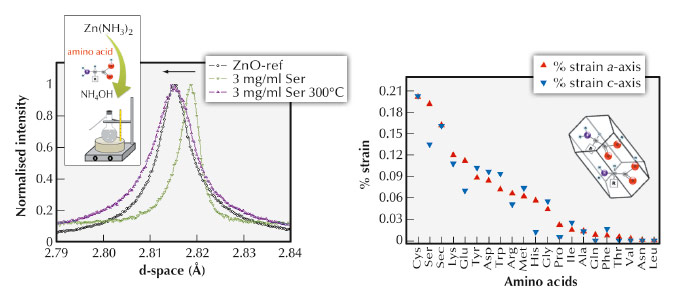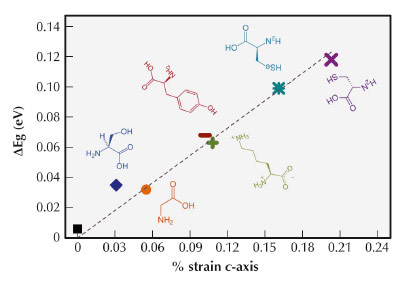- Home
- Users & Science
- Scientific Documentation
- ESRF Highlights
- ESRF Highlights 2013
- Structure of materials
- Bio-inspired band-gap engineering of zinc oxide: HR-XRD study of amino acid intra-crystalline incorporation
Bio-inspired band-gap engineering of zinc oxide: HR-XRD study of amino acid intra-crystalline incorporation
Crystals produced by organisms are attracting extensive scientific interest because they present enhanced structural properties as compared to non-biogenic crystals. Particular attention has been directed to biogenic calcium carbonate owing to its enhanced fracture toughness. This is achieved by the presence of intra-crystalline organic molecules within individual crystals. These intra-crystalline molecules have also been shown to strongly influence crystal shape, morphology and coherence length [1]. Another outcome of their presence is the existence of systematic anisotropic lattice strain [2]. We have shown previously that incorporation of proteins and even of single amino acids into synthetically grown calcium carbonate leads to similar lattice strain [3].
So far, we know of no studies showing that amino acids or biological molecules can become incorporated into the lattice structures of non-carbonate materials. By high-resolution X-ray powder diffraction at beamline ID31, we found that in a manner similar to that observed for calcium carbonate, amino acids can be incorporated into the crystal lattice of ZnO. We show, moreover, that such incorporation exists and that the induced lattice strain accompanying the incorporation leads to systematic changes in the band gap of the semiconductor host.
Our first objective was to determine whether amino acids could become incorporated into the lattice of ZnO. To this end we grew ZnO in the presence of various amino acids at different solution concentrations. In the test case of serine, we found that serine indeed became incorporated and induced lattice strain of up to about 0.2% in the ZnO host. As the level of incorporation increased, so did the strain. Moreover, similarly to that observed in biogenic and biomimetic calcium carbonate, the strain relaxed upon mild thermal air annealing (300°C for 90 min) and a unique microstructure developed, characterised by broadening of the diffraction peaks (Figure 126a).
We then screened all the common amino acids and found that a reasonable number of them do indeed become incorporated at different levels (along both a-axis and c-axis) into the ZnO lattice, with resulting lattice strain (Figure 126b).
 |
|
Fig. 126: a) (100) Diffraction peak of ZnO crystals of pure ZnO (dashed black), ZnO grown in the presence of 3 mg/ml serine before (green) and after annealing at 300°C for 90 min (purple). b) Lattice strain of ZnO with incorporated amino acids along the a-axis (red) and along the c-axis (blue). |
These results clearly demonstrated that the incorporation of amino acids into other crystalline materials is feasible and might even be a widespread phenomenon. We believe that these findings can have considerable impact on tuning the properties of new functional materials. In the present case, because ZnO is a semiconductor, we expected that the incorporation of organic molecules within the host lattice and the resulting lattice strain induction would alter the electronic properties as compared to pure ZnO crystals. We therefore measured the optical band gap of our amino acid-incorporating ZnO crystals.
By collecting diffuse reflectance spectra with a UV-spectrophotometer and applying the Kubelka-Munk method, we screened the band gap alternation of ZnO/amino acid composites, before and after thermal annealing, compared to a reference sample (Figure 127). It was interesting to observe, firstly, that the band gap was indeed altered due to the amino acid incorporation, and secondly that there is a linear relationship between the magnitude of strain induced by the incorporation and the change in band gap of the ZnO crystalline host .
 |
|
Fig. 127: Band gap energy values variation before and after annealing (ΔEg) as a function of c-axis strain of ZnO samples crystallised in the presence of different amino acids. |
The key experimental results obtained were (1) that amino acids can be incorporated into other inorganic crystalline hosts, ZnO in the present case, and (2) that incorporation of amino acids into an inorganic crystalline semiconductor host induces not only lattice strain, as previously observed in biogenic and biomimetic calcium carbonate, but also a considerable band gap shift. We believe, moreover, that this could announce a new bio-inspired route, in addition to and in combination with current methods, for tuning of the band gaps of semiconductors.
Principal publication and authors
A. Brif (a), G. Ankonina (a), C. Drathen (b) and B. Pokroy (a), Adv. Mater. 26, 477-481 (2014).
(a) Materials Science & Engineering and the Russell Berrie Nanotechnology Institute, Technion - Israel Institute of Technology, Haifa (Israel)
(b) ESRF
References
[1] A. Berman, J. Hanson, L. Leiserowitz, T.F. Koetzle, S. Weiner and L. Addadi, Science 259, 776 (1993).
[2] B. Pokroy, J.P. Quintana, E.N. Caspi, A. Berner and E. Zolotoyabko, Nat. Mater. 3, 900 (2004). [3] S. Borukhin, L. Bloch, T. Radlauer, A. H. Hill, A. N. Fitch and B. Pokroy, Adv. Funct. Mater. 22, 4216 (2012).



